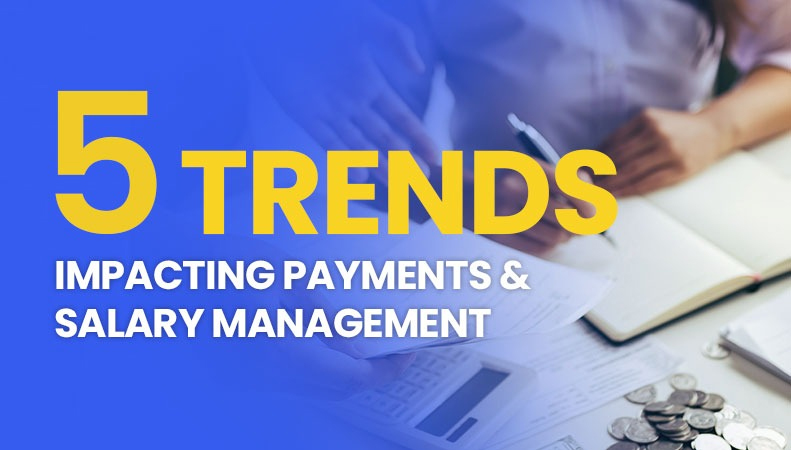
5 TRENDS IMPACTING PAYMENTS AND SALARY MANAGEMENT
6th January 2022
Contactless payments - the means to pay by tapping a physical card, wearable device, or smartphone over a card reader using RFID or NFC technology — were already on the precipice of becoming a world norm. However, due to the epidemic, adoption expanded swiftly, and in 2021, continues to grow. Consumers all over the world are opting to shop at stores that accept contactless payments. Nearly two-thirds (63 percent) of consumers would switch to a new shop that offered contactless payment choices provided all other factors were equal (price, selection, and location).
While security was a major factor in the spread of contactless payments in 2020, ease and simplicity will be the driving factors in 2021. Nearly half of those surveyed (46%) had already changed their top-of-wallet card with a contactless-enabled card. Businesses that promote their contactless payment acceptance will gain more clients and be better positioned for growth this year. Contactless payments will not only speed up in-store transactions, but they will also play a role in multichannel, or the cross-channel buying experience that consumers have come to expect. As quarantine regulations increased, in-store shopping became uncomfortable and hazardous, and worldwide customers quickly turned to online shops for common household needs.
QR code payments are becoming more popular to facilitate omnichannel commerce. Throughout the next five years, QR code payments will be the most widely utilized digital commerce technique in terms of volume. For example, an increasing number of restaurants are employing QR codes to allow customers to see menus and pay for orders directly from their smartphones. Ecommerce live streaming, the internet version of TV infomercials, is now powered by QR codes. Influencers advertise products on their social media platforms, flashing the QR code on the screen so that customers may go straight to the online shopping cart and buy the item. It's like television infomercials, except it's more interactive.
5 Emerging Global Payroll Trends
1. Using a Platform-Based System of Record
While most multinational firms have implemented gross pay for a solid 80 percent of their employees, this often only covers approximately 20% of their locations. Satellite offices and remote staff have sprung up all over the world due to globalization. While a diverse and dispersed workforce adds to a company's skill set and diversity, it also adds to its complexity. Because of the many time zones, holidays, employee types, and restrictions, businesses are forced to rely on a variety of costly ad hoc solutions to handle local payroll, with variable outcomes. Global payroll executives have begun to identify a solution in the form of a platform approach as leakages increase and visibility declines.
Businesses can have a single source of truth for a time, pay, compliance, and more with all locations, time, and gross pay in one place. Scalability is easier to achieve in a platform setup, allowing for greater flexibility in these uncertain times. Mergers, expansion into new sectors, legislation changes, and even political turbulence are all present and very real elements in global payroll administration, and fragmented data solutions have not yet proven up to the challenge. The capacity to shift gears quickly is more vital than ever before, and because a company's efficiency is only as good as the sum of its locations, everyone must be on the same page.
2. Mobile and Remote: The New Normal
Because of the large number of competent remote workers, corporations are finally recognizing them as a substantial portion of the workforce. This also entails dealing with the significant lack of control, engagement, and visibility that they bring to the workplace. Remote, mobile, and deskless workers require sophisticated mobile apps to meet their self-service needs. Modern user interfaces and non-intrusive data capturing are naturally included in the best systems, allowing your deskless workforce to positively impact outcomes while aggregating all data within the same safe system.
3. Putting Compliance in the Spotlight
A review of payroll headlines from the last decade indicates a slew of overtime mistakes and costly breaches. Millions of dollars can "disappear" if meticulous efforts to preserve compliance are not implemented, and the hazards can extend beyond financial implications, badly harming the company's brand and even straining management-worker relationships. To put it another way, a business cannot develop globally unless it has a reliable compliance solution. Organizations are now seeking out-of-the-box compliance integrated into their solutions as they begin to move away from local vendors or suffocating payroll/HR departments deciphering local requirements. More businesses will eventually have access to automatic compliance for any area, state, or country, which will be comprehensive and updated as requirements change. Even where compliance necessitates something more customized—such as complex business agreements or union rules—new solutions will need to accommodate this by implementing a comprehensive pay rule engine to assist labor compliance in any situation.
4. AI and Machine Learning’s Place in the Industry
The future is today, and it's more "now" than ever because of the slow but steady normalization of biometrics, intelligent processes, and smart validations. Using cutting-edge artificial intelligence (AI)-powered cloud technologies such as Face ID or chatbots has ushered in a new era of unobtrusive time tracking and pay calculation. Businesses want to collect as much data as possible with the least amount of work from supervisors and employees, and the appeal of employing facial recognition to eliminate ID badges, passwords, and signing in lines is hard to ignore. Even friendlier, chatbots provide a more conversational AI, allowing employees to simply strike up a conversation about their time, boosting adoption and ensuring more accurate data collecting. All of this is quick and easy, and it gives you the advantages of biometrics without the added hardware costs.
The above-mentioned powerful new features only scratch the surface of what AI has brought to payroll. Teams may automate workflows around approval and payroll processes using intelligent business processes to match their specific needs. Furthermore, all this self-service AI aids in the achievement of unobtrusive, accurate, and secure time management, as well as the transmission of gross pay compliance files to payroll for export, and the learning of common exceptions and validations. Everything happens in real-time, with built-in exceptions, so each department's managers can see what's going on when it matters.
5. Effortless Integrations
A single platform is the first step toward bringing diverse systems together, but advanced integrations are the final step. Disrupting an organization's existing ecology can be time-consuming and costly. Employee data, for example, is kept in the human resources management system (HRMS), whereas time and pay data is kept in payroll. Companies can connect time and pay to employees by integrating these technologies, allowing them to better manage performance, productivity, and engagement. This gives HR a broad picture of the organization, as well as tactical advantages like managing time off policy and responsibility. Cloud software is also becoming more significant, as it can easily deliver data to both global and local systems in HR, payroll, and other areas.
EVOLET creates financial accessibility for the unbanked.
Aside from worker convenience, the digital wallet — which is regulated by Bank Negara Malaysia — is designed first and foremost as a payroll administration tool, which is a significant cost-saving service for employers, as cash transfer is both pricey and often dangerous. EVOLET provides companies with secure income administration and migratory workers with financial access, control, and savings on essential needs. EVOLET enables unbanked people to access financial services.
This is done by the central bank's Financial Action Task Force to resolve gaps in high-risk countries with insufficient anti-money laundering, anti-terrorism funding, and anti-proliferation financing policies. While these rules are important for safeguarding the global financial system, most migrant workers are unable to provide the additional documentation required to create bank accounts, and employers find the process excessively time-consuming. Undocumented workers, on the other hand, clearly want to be compensated in cash. They quickly remit the money to their home nations after receiving the payment. It's a once-a-month event. Some companies have told us that their employees will take a half-day off after they are paid every month. They must rush out to remit a substantial amount of their pay home because they are paid in cash.
As a result, individuals become reliant on cash-transfer agents and remittance services, as earnings are paid in cash, increasing their chances of being theft victims. Companies opted to focus on payroll administration, followed by remittance services for the migratory workforce, after realizing that the problem begins with having a secure place to deposit their money. It is necessary to create a haven for them to save their wages. Our primary goal at EVOLET is to provide secure salary management for companies. Employers are charged RM1 per employee, making EVOLET payment management systems the most cost-effective on the market.
EVOLET is a digital wallet app for migrant workers.
Learn more at https://evolet.io/
